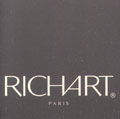
Impact
Appearance 4.1 / 5
| Color: | rusted crimson ground into dark brown |
| Surface: | |
| Temper: | flat sheen |
| Snap: | solid & strong |
Aroma 7.7 / 10
coffee, cigar, & a little caramel fill the airwaves at medium strength; aerates BMX rubber (laid out on asphalt &/or gas-dried?)
Mouthfeel 13.2 / 15
| Texture: | lone high point of the experience |
| Melt: | true |
Flavor 34.8 / 50
coffee caramel -> vulcanized chocolate rubber -> potted soil -> runs flat into a mushroom patch w/ a scrap of mango -> tobacco & tea leaves -> short rising astringency leads to cheap rum
Quality 12.4 / 20
Caramel expressed hopes of maybe an off-shore Carenero in the making. Instead, a stale rout; nothing vibrant or vital in the humble crop, &/or substandard post-harvest & processing from this rarely attempted origin.
Becoming apparent too is the equalizing roast Richart applies to almost every origin, treating each like the exact same place. DR cacáo has been coming strong (witness Ancones, Vista Alegre, or even Mast Bros) that this bar shows these poor quality beans are obviously sourced from the impoverished side of the island – in Haiti, yet another sad reminder of the dismal state of affairs into which that country is plunged.
For the record, 'Santo Domingo' was a genotype in the 19th century more widely known as the ‘Creole’ transplanted from Martinique by French settlers.
The only saving grace: relatively mild for 82% - thanks to generous cacáo butter content – with a perceived sweetness greater than its actual weight in sugar.
Becoming apparent too is the equalizing roast Richart applies to almost every origin, treating each like the exact same place. DR cacáo has been coming strong (witness Ancones, Vista Alegre, or even Mast Bros) that this bar shows these poor quality beans are obviously sourced from the impoverished side of the island – in Haiti, yet another sad reminder of the dismal state of affairs into which that country is plunged.
For the record, 'Santo Domingo' was a genotype in the 19th century more widely known as the ‘Creole’ transplanted from Martinique by French settlers.
The only saving grace: relatively mild for 82% - thanks to generous cacáo butter content – with a perceived sweetness greater than its actual weight in sugar.





